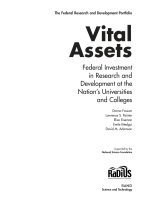Investment appraisal spot and derivative markets
Bạn đang xem bản rút gọn của tài liệu. Xem và tải ngay bản đầy đủ của tài liệu tại đây (110.19 KB, 18 trang )
Investment Appraisal
Chapter 3
Investments: Spot and Derivative
Markets
Compounding vs. Discounting
• Invest sum over years, how much will it be worth?
• Terminal Value after n years @ r :
–
TVn = P ( 1 + r )
n
if r1 = r2 = … = rn
– 1000 (1.1)2 = 1210
• Offer a final sum in n years, how much should I get now?
• Discounted Present Value:
–
DPV =
TVn
( 1+ r )
n
1210
=
= 1000
2
1.1
• Discounting is the inverse or mirror image of
Lecture III: Investment Appraisal
compounding.
2
Investment Appraisal
(a.k.a. Capital Budgeting)
• Central concepts:
– Capital cost (KC)
– Opportunity cost of capital (typically r)
– Net Present Value (NPV)
– Internal Rate of Return (IIR)
– In principle equivalent concepts, but one may
be more informative than another, depending
on the context used.
Lecture III: Investment Appraisal
3
A Project Proposal
• Cash Flow:
– CF1 = 1100 and CF2 = 1210
• KC = 2100
• R = 10%
• Should you invest?
• 2310 > 2100
Lecture III: Investment Appraisal
4
NPV
•
DPVCF
CF1
CF2
1100 1210
=
+
=
+
= 2000
2
2
1.1 ( 1.1)
( 1+ r ) ( 1+ r )
• KC = 2100
• DPV – KC < 0
• Do not invest, because opportunity cost of
capital not compensated for.
• Equivalently,
– Place KC in bank for 2 years: TVKC = 2541
– Terminal Value of Project: 2420
– Why?
Lecture III: Investment Appraisal
5
IRR
• IRR is that rate of interest that equates an initial
outlay with the DPV of an income stream.
1100 1210
2000 =
+
2
1+ y ( 1+ y)
• y=?
• Implicit assumptions:
– y is an average growth rate.
– All payments received before the terminal investment
are re-invested at y. Why?
Lecture III: Investment Appraisal
6
Different CF Profiles
• {-,-,…,+,+,…} NPV>KC or y > r Invest
• {+,+,…,-,-,…} NPV>KC or y < r Invest
• {-,+,-,...} NPV>KC Invest. IRR
ambiguous.
Lecture III: Investment Appraisal
7
Mutually Exclusive Projects
• Scale/Timing Problem:
{CFt, CFt+1}
– Project A: {-10, +15} with r = 10% IRR = 50%, NPV
= 3.64
– Project B: {-80, +110} & r = 10% IRR = 37.5, NPV
= 20.
– Use NPV or adjust IRR:
– Incremental CF: CFB – CFA = {-70, 95}
105
0 = −70 +
– Incremental IRR:
( 1 + IncIRR )
35.7% > r
95
−70 +
= 16.36 > 0
– Incremental NPV
Lecture III: Investment Appraisal
1.1
8
Real vs. Nominal
(1+rn) = (1+rr)(1+π)
• Nominal CF discounted at nominal rate
• Real CF discounted at real rate
• Assume π = 5%, rr = 3% & get €100 in a
year:
100/1.0815 = 100(1.05*1.03) = 92.464
100/1.05 = 95.238
95.238/1.03 = 92.464
Lecture III: Investment Appraisal
9
Timing of Capital Expenditures
• The timing of the initiation of a project can be crucial. But
when is a good time?
• Delays imply lose out on revenue but save on interest
payments.
• If we know the CFs (and r) with certainty we can work
out the NPV of the project at different start dates.
• Take care express the NPVs for different start dates in
present value terms (i.e. NPV1 is discounted for one
period, NPV2 for two periods…).
• Choose Project with highest NPV.
• Intuitive delay if growth in NPV > r
Lecture III: Investment Appraisal
10
Uncertainty & Risk
• Cash Flows (& r) tend to vary over time.
• Use probability distributions to account for
this: use expected CF
• E.g., a good and a bad state of the
economy {VG, VB} = {100, 40} & {PrG = 0.75,
PrB = 0.25}:
Ve = 0.75*100 + 0.25*40 = 85
NPV = -KC + Ve /(1+r)
Lecture III: Investment Appraisal
11
• Decision Trees:
– How many contingencies?
– Exponential increase in complexity over time.
• Liquidation Value
• Real Options Theory, Sensitivity Analysis, Scenario
Analysis
• Discount Factor:
– ‘Safe’ Rate? Projections of yield curve.
– Risk Premium? (, e.g. CAPM, WACC)
• Capital Rationing NPV fails, so use Profitability Index
to rank projects:
DPV CF
PI =
(
KC
)
Lecture III: Investment Appraisal
12
Other Decision Rules
• Payback Period:
– Number of years it takes for CF to exceed KC.
– Problem is CF not discounted.
– Unsophisticated (and therefore useful) Rule of Thumb often
used alongside NPV.
– More frequently used in small firms and Europe according to
CEO survey.
• Return on Capital Employed (ROC)
[Return on Investment (ROI), Accounting Rate of Return
(ARR)]:
– ‘Profits’/KC
– What profits to use? Current, average past, projections…
– Investment may take place over several periods.
Lecture III: Investment Appraisal
13
Financing & Investment Decisions
• The financing and investment decisions are treated
separately A project’s PV is calculated independent of
debt considerations.
• Many possible sources of finance Weighted Average
Cost of Capital. Consider a Debt & Equity financed firm
for example:
1 + rWACC
D
E
=
÷( 1 + rD ) +
÷( 1 + rE )
D+E
D+E
• Does bankruptcy risk increase WACC? Chapter 11
Modigliani & Miller ‘Irrelevance of Funding Theorem’.
Lecture III: Investment Appraisal
14
Some Practical Considerations
•
•
•
•
EBITD = Revenue – Inputs Costs
Depreciation (price, scrap value, lifetime)
Tax
T = t(R-C-D)
Post tax CF:
CFPost Tax = (R-C)(1-t)+tD
• tD is the depreciation tax shield
Lecture III: Investment Appraisal
15
Working Capital
• Predictions on CF & KC tend to be
smoothed out, WC is to account for the
leads and lags.
• WC = Inventory + accounts receivable –
accounts payable
• Change in WC = Change in inventory +
change in accounts receivable – change in
accounts payable
Lecture III: Investment Appraisal
16
• Opportunity Cost
• Sunk Costs
Lecture III: Investment Appraisal
17
M&A
Gain = NPVA+ B − ( NPVA + NPVB ) − tc
• Success? Mixed assessment & difficult to assess NPVA+B.
• Synergies? Economies of scale related cost sharing, market power,
customer base, …
• Are these beneficial to society?
• Discount Rate?
– Horizontal (similar industry & rate) vs. Vertical (prob. differ) Merger
• Shareholder Maximisation vs. Empire Building
• Free Cash-Flow Hypothesis: M. C. Jensen, ‘The Performance of
Mutual Funds in the Period 1945-1964’ Journal of Finance, 1968,
23, 389—416.
• Should invest in all own projects with NPV > 0, then release excess
cash to shareholders to invest as they want. M&A only if gains
accrue from joining itself.
Lecture III: Investment Appraisal
18









